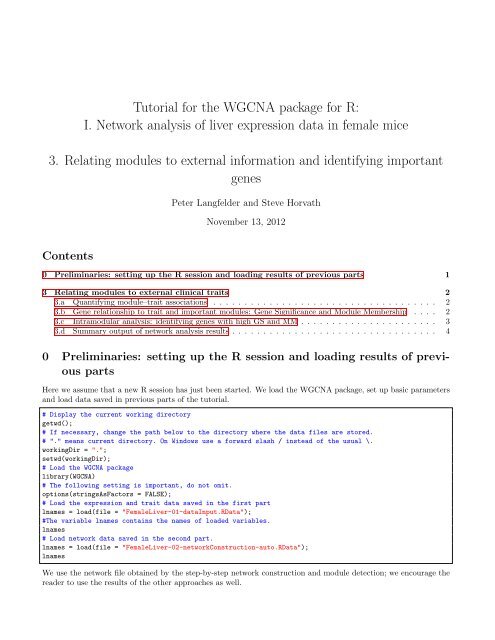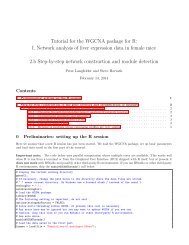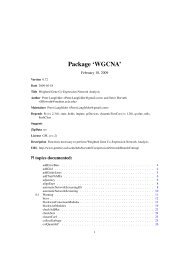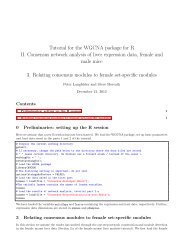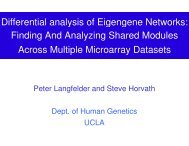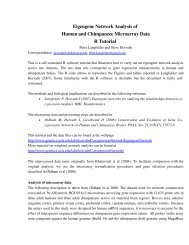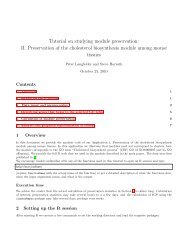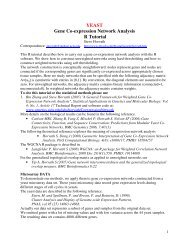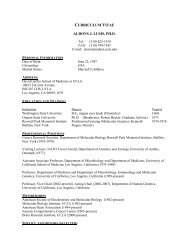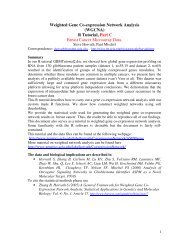Tutorial for the WGCNA package for R - UCLA Human Genetics
Tutorial for the WGCNA package for R - UCLA Human Genetics
Tutorial for the WGCNA package for R - UCLA Human Genetics
You also want an ePaper? Increase the reach of your titles
YUMPU automatically turns print PDFs into web optimized ePapers that Google loves.
<strong>Tutorial</strong> <strong>for</strong> <strong>the</strong> <strong>WGCNA</strong> <strong>package</strong> <strong>for</strong> R:I. Network analysis of liver expression data in female mice3. Relating modules to external in<strong>for</strong>mation and identifying importantgenesPeter Langfelder and Steve HorvathNovember 13, 2012Contents0 Preliminaries: setting up <strong>the</strong> R session and loading results of previous parts 13 Relating modules to external clinical traits 23.a Quantifying module–trait associations . . . . . . . . . . . . . . . . . . . . . . . . . . . . . . . . . . . . 23.b Gene relationship to trait and important modules: Gene Significance and Module Membership . . . . 23.c Intramodular analysis: identifying genes with high GS and MM . . . . . . . . . . . . . . . . . . . . . . 33.d Summary output of network analysis results . . . . . . . . . . . . . . . . . . . . . . . . . . . . . . . . . 40 Preliminaries: setting up <strong>the</strong> R session and loading results of previouspartsHere we assume that a new R session has just been started. We load <strong>the</strong> <strong>WGCNA</strong> <strong>package</strong>, set up basic parametersand load data saved in previous parts of <strong>the</strong> tutorial.# Display <strong>the</strong> current working directorygetwd();# If necessary, change <strong>the</strong> path below to <strong>the</strong> directory where <strong>the</strong> data files are stored.# "." means current directory. On Windows use a <strong>for</strong>ward slash / instead of <strong>the</strong> usual \.workingDir = ".";setwd(workingDir);# Load <strong>the</strong> <strong>WGCNA</strong> <strong>package</strong>library(<strong>WGCNA</strong>)# The following setting is important, do not omit.options(stringsAsFactors = FALSE);# Load <strong>the</strong> expression and trait data saved in <strong>the</strong> first partlnames = load(file = "FemaleLiver-01-dataInput.RData");#The variable lnames contains <strong>the</strong> names of loaded variables.lnames# Load network data saved in <strong>the</strong> second part.lnames = load(file = "FemaleLiver-02-networkConstruction-auto.RData");lnamesWe use <strong>the</strong> network file obtained by <strong>the</strong> step-by-step network construction and module detection; we encourage <strong>the</strong>reader to use <strong>the</strong> results of <strong>the</strong> o<strong>the</strong>r approaches as well.
3 Relating modules to external clinical traits3.a Quantifying module–trait associationsIn this analysis we would like to identify modules that are significantly associated with <strong>the</strong> measured clinical traits.Since we already have a summary profile (eigengene) <strong>for</strong> each module, we simply correlate eigengenes with externaltraits and look <strong>for</strong> <strong>the</strong> most significant associations:# Define numbers of genes and samplesnGenes = ncol(datExpr);nSamples = nrow(datExpr);# Recalculate MEs with color labelsMEs0 = moduleEigengenes(datExpr, moduleColors)$eigengenesMEs = orderMEs(MEs0)moduleTraitCor = cor(MEs, datTraits, use = "p");moduleTraitPvalue = corPvalueStudent(moduleTraitCor, nSamples);Since we have a moderately large number of modules and traits, a suitable graphical representation will help inreading <strong>the</strong> table. We color code each association by <strong>the</strong> correlation value:sizeGrWindow(10,6)# Will display correlations and <strong>the</strong>ir p-valuestextMatrix = paste(signif(moduleTraitCor, 2), "\n(",signif(moduleTraitPvalue, 1), ")", sep = "");dim(textMatrix) = dim(moduleTraitCor)par(mar = c(6, 8.5, 3, 3));# Display <strong>the</strong> correlation values within a heatmap plotlabeledHeatmap(Matrix = moduleTraitCor,xLabels = names(datTraits),yLabels = names(MEs),ySymbols = names(MEs),colorLabels = FALSE,colors = greenWhiteRed(50),textMatrix = textMatrix,setStdMargins = FALSE,cex.text = 0.5,zlim = c(-1,1),main = paste("Module-trait relationships"))The resulting color-coded table is shown in Fig. 1.The analysis identifies <strong>the</strong> several significant module–trait associations. We will concentrate on weight as <strong>the</strong> traitof interest.3.b Gene relationship to trait and important modules: Gene Significance and ModuleMembershipWe quantify associations of individual genes with our trait of interest (weight) by defining Gene Significance GS as(<strong>the</strong> absolute value of) <strong>the</strong> correlation between <strong>the</strong> gene and <strong>the</strong> trait. For each module, we also define a quantitativemeasure of module membership MM as <strong>the</strong> correlation of <strong>the</strong> module eigengene and <strong>the</strong> gene expression profile. Thisallows us to quantify <strong>the</strong> similarity of all genes on <strong>the</strong> array to every module.# Define variable weight containing <strong>the</strong> weight column of datTraitweight = as.data.frame(datTraits$weight_g);names(weight) = "weight"# names (colors) of <strong>the</strong> modulesmodNames = substring(names(MEs), 3)geneModuleMembership = as.data.frame(cor(datExpr, MEs, use = "p"));MMPvalue = as.data.frame(corPvalueStudent(as.matrix(geneModuleMembership), nSamples));
MEmagentaMEblackMEturquoiseMEgreenMElightcyanMEgreenyellowMEblueMEbrownMEredMEsalmonMEyellowMElightgreenMEgreyMEpinkMEgrey60MEpurpleMEtanMEcyanMEmidnightblueweight_glength_cmab_fato<strong>the</strong>r_fattotal_fatX100xfat_weightTriglyTotal_CholModule−trait relationships−0.017 0.08 −0.0056−0.033−0.017−0.0630.023 −0.037 0.053 −0.074 −0.13 −0.095−0.039−0.028−0.0110.082 −0.064 0.051 0.015−0.00110.19 −0.094−0.053−0.0340.08 0.015(0.8) (0.4) (0.9) (0.7) (0.8) (0.5) (0.8) (0.7) (0.5) (0.4) (0.1) (0.3) (0.7) (0.7) (0.9) (0.3) (0.5) (0.6) (0.9) (1) (0.03) (0.3) (0.5) (0.7) (0.4) (0.9)−0.31 −0.15 −0.27 −0.15 −0.24 −0.18 −0.073 −0.16 −0.07 −0.2 −0.24 −0.28 −0.15 0.055 −0.33 0.45 −0.37 −0.12 0.18 0.096 0.084 0.044 0.03 −0.044 −0.27 −0.29(2e−04) (0.07) (0.001) (0.09) (0.006) (0.04) (0.4) (0.07) (0.4) (0.02) (0.006)(9e−04)(0.08) (0.5) (1e−04)(7e−08)(1e−05)(0.2) (0.04) (0.3) (0.3) (0.6) (0.7) (0.6) (0.002)(6e−04)−0.27 −0.15 −0.33 −0.059 −0.24 −0.21 0.011 −0.094 −0.15 −0.063 0.029 −0.06 −0.088 0.02 −0.097 0.23 −0.38 −0.12 0.091 0.18 0.13 0.054 0.063 0.025 −0.25 −0.22(0.001) (0.09) (1e−04) (0.5) (0.005) (0.01) (0.9) (0.3) (0.09) (0.5) (0.7) (0.5) (0.3) (0.8) (0.3) (0.009)(4e−06)(0.2) (0.3) (0.04) (0.1) (0.5) (0.5) (0.8) (0.004) (0.01)0.0013 −0.13 −0.034 0.22 0.078 0.11 −0.1 0.036 −0.18 0.03 −0.013−0.0260.043 0.051 −0.051 0.15 −0.22 −0.1 0.17 0.22 0.16 0.074 0.043−0.0016−0.28−0.22(1) (0.1) (0.7) (0.01) (0.4) (0.2) (0.3) (0.7) (0.03) (0.7) (0.9) (0.8) (0.6) (0.6) (0.6) (0.09) (0.01) (0.2) (0.06) (0.01) (0.07) (0.4) (0.6) (1) (9e−04)(0.009)−0.13 −0.12 −0.2 0.076 −0.087−0.086−0.05 −0.1 −0.1 −0.11 −0.081 −0.16 −0.1 0.067 −0.12 0.25 −0.3 −0.12 0.18 0.21 0.2 0.033 0.12 0.059 −0.29 −0.27(0.1) (0.2) (0.02) (0.4) (0.3) (0.3) (0.6) (0.2) (0.2) (0.2) (0.4) (0.06) (0.3) (0.4) (0.2) (0.004)(5e−04)(0.2) (0.04) (0.02) (0.02) (0.7) (0.2) (0.5) (6e−04)(0.002)−0.022 0.05 0.024 0.13 0.087 0.13 −0.043−0.029−0.083−0.018−0.03 −0.076−0.026−0.0970.066 −0.14 −0.085 −0.12−0.00290.0930.049 −0.078 0.024 −0.061 0.078−0.0017(0.8) (0.6) (0.8) (0.1) (0.3) (0.1) (0.6) (0.7) (0.3) (0.8) (0.7) (0.4) (0.8) (0.3) (0.4) (0.1) (0.3) (0.2) (1) (0.3) (0.6) (0.4) (0.8) (0.5) (0.4) (1)0.31 0.036 0.29 0.23 0.29 0.26 −0.011 0.098 −0.086 0.068 0.065 0.15 0.1 0.24 0.02 −0.12 0.25 0.062 0.19 −0.086 −0.16 −0.087 −0.22 −0.18 −0.088−0.023(2e−04) (0.7) (6e−04)(0.008)(7e−04)(0.002)(0.9) (0.3) (0.3) (0.4) (0.5) (0.07) (0.2) (0.006) (0.8) (0.2) (0.003) (0.5) (0.03) (0.3) (0.06) (0.3) (0.01) (0.04) (0.3) (0.8)0.59 0.1 0.48 0.47 0.53 0.51 −0.15 0.33 0.075 0.33 0.32 0.34 0.32 0.13 0.34 −0.43 0.43 0.069 −0.11 −0.082 −0.12 0.071 −0.0980.0093−0.0320.068(5e−14) (0.2) (3e−09)(9e−09)(3e−11)(3e−10)(0.09) (1e−04) (0.4) (8e−05)(1e−04)(6e−05)(1e−04)(0.1) (5e−05)(3e−07)(2e−07)(0.4) (0.2) (0.3) (0.2) (0.4) (0.3) (0.9) (0.7) (0.4)0.51 0.15 0.42 0.43 0.47 0.45 0.035 0.34 0.1 0.28 0.2 0.29 0.34 0.096 0.27 −0.41 0.42 0.13 −0.1 −0.16 −0.11 −0.092 −0.14 −0.029 0.07 0.12(3e−10) (0.08) (6e−07)(3e−07)(1e−08)(6e−08)(0.7) (6e−05) (0.2) (0.001) (0.02) (8e−04)(7e−05)(0.3) (0.002)(1e−06)(4e−07)(0.1) (0.2) (0.07) (0.2) (0.3) (0.1) (0.7) (0.4) (0.2)0.43 0.22 0.36 0.3 0.37 0.32 0.17 0.27 0.13 0.29 0.35 0.33 0.26 −0.11 0.47 −0.58 0.26 −0.011 −0.12 −0.081−0.0610.15 0.032 0.13 0.13 0.17(2e−07) (0.01) (2e−05)(5e−04)(8e−06)(1e−04)(0.06) (0.002) (0.1) (6e−04)(3e−05)(9e−05)(0.002)(0.2) (1e−08)(3e−13)(0.002)(0.9) (0.2) (0.4) (0.5) (0.09) (0.7) (0.1) (0.1) (0.05)0.22 0.05 0.18 0.22 0.21 0.2 0.1 0.3 0.075 0.37 0.42 0.41 0.3 −0.16 0.41 −0.46 0.2 0.013 −0.11−0.0026−0.0460.13 0.03 0.085 0.22 0.33(0.01) (0.6) (0.04) (0.01) (0.01) (0.02) (0.2) (4e−04) (0.4) (1e−05)(4e−07)(6e−07)(5e−04)(0.06) (7e−07)(2e−08)(0.02) (0.9) (0.2) (1) (0.6) (0.1) (0.7) (0.3) (0.01) (1e−04)−0.057 0.13 −0.0094−0.047−0.03 −0.015 0.01 −0.031 0.067 −0.047−0.055−0.018−0.033−0.062−0.0210.069 −0.15 −0.024 0.065 0.011 0.04 0.048 0.00044 0.031 0.14 0.099(0.5) (0.1) (0.9) (0.6) (0.7) (0.9) (0.9) (0.7) (0.4) (0.6) (0.5) (0.8) (0.7) (0.5) (0.8) (0.4) (0.07) (0.8) (0.5) (0.9) (0.6) (0.6) (1) (0.7) (0.1) (0.3)0.09 0.14 0.15 −0.015 0.11 0.09 −0.05−0.00380.13 −0.0099−0.0052−0.047−0.0084−0.21−0.037−0.0250.061 −0.058 −0.02 −0.028−0.0260.15 −0.054 0.08 0.079 0.069(0.3) (0.1) (0.09) (0.9) (0.2) (0.3) (0.6) (1) (0.1) (0.9) (1) (0.6) (0.9) (0.02) (0.7) (0.8) (0.5) (0.5) (0.8) (0.7) (0.8) (0.09) (0.5) (0.4) (0.4) (0.4)−0.051 0.072 0.013 −0.24 −0.1 −0.13 0.052 −0.15 0.067 −0.21 −0.26 −0.23 −0.15 0.045 −0.17 0.1 0.16 0.11 −0.064 −0.17 −0.096 −0.17 −0.091−0.0620.16 0.04(0.6) (0.4) (0.9) (0.005) (0.2) (0.1) (0.5) (0.08) (0.4) (0.02) (0.002)(0.008)(0.07) (0.6) (0.06) (0.2) (0.06) (0.2) (0.5) (0.05) (0.3) (0.04) (0.3) (0.5) (0.07) (0.6)−0.017−0.0730.061 0.0097 0.045 0.077 −0.021 0.025 0.0029 0.067 0.061 0.046 0.024 0.029 −0.087 0.19 0.0069 0.12 −0.016−0.062−0.062−0.0047−0.099−0.054−0.03 −0.085(0.8) (0.4) (0.5) (0.9) (0.6) (0.4) (0.8) (0.8) (1) (0.4) (0.5) (0.6) (0.8) (0.7) (0.3) (0.03) (0.9) (0.2) (0.9) (0.5) (0.5) (1) (0.3) (0.5) (0.7) (0.3)−0.021−0.0220.049 −0.096−0.0120.0054−0.0068−0.079−0.092−0.092−0.15 −0.091−0.076−0.098−0.075−0.0340.096 0.061 0.042 0.0018 −0.07 −0.099 0.018 −0.1 0.076 0.049(0.8) (0.8) (0.6) (0.3) (0.9) (1) (0.9) (0.4) (0.3) (0.3) (0.08) (0.3) (0.4) (0.3) (0.4) (0.7) (0.3) (0.5) (0.6) (1) (0.4) (0.3) (0.8) (0.2) (0.4) (0.6)0.27 0.18 0.32 0.15 0.28 0.27 −0.014 0.21 0.16 0.21 0.14 0.23 0.21 −0.11 0.2 −0.32 0.28 0.034 −0.12 −0.12 −0.098 0.11 −0.018−0.00880.26 0.32(0.002) (0.04) (2e−04) (0.08) (0.001)(0.002)(0.9) (0.01) (0.06) (0.02) (0.1) (0.007) (0.02) (0.2) (0.02) (2e−04)(8e−04)(0.7) (0.2) (0.2) (0.3) (0.2) (0.8) (0.9) (0.002)(2e−04)0.18 0.15 0.25 0.061 0.18 0.15 −0.075 0.044 0.2 −0.0037−0.12−0.065 0.037 −0.022 0.014 −0.12 0.22 0.047 −0.08 −0.16 −0.052 0.084 −0.03 0.058 0.076 0.016(0.04) (0.07) (0.004) (0.5) (0.03) (0.09) (0.4) (0.6) (0.02) (1) (0.2) (0.5) (0.7) (0.8) (0.9) (0.2) (0.01) (0.6) (0.4) (0.06) (0.5) (0.3) (0.7) (0.5) (0.4) (0.9)0.19 −0.024 0.22 0.27 0.27 0.28 −0.11 0.13 −0.052 0.11 0.0012 0.031 0.13 0.015 0.011 −0.04 0.035 −0.02 0.075 0.065 0.047 0.15 −0.0190.0039−0.12 −0.076(0.03) (0.8) (0.01) (0.002) (0.002)(9e−04)(0.2) (0.1) (0.5) (0.2) (1) (0.7) (0.1) (0.9) (0.9) (0.6) (0.7) (0.8) (0.4) (0.5) (0.6) (0.08) (0.8) (1) (0.2) (0.4)HDL_CholUCFFAGlucoseLDL_plus_VLDLMCP_1_physInsulin_ug_lGlucose_InsulinLeptin_pg_mlAdiponectinAortic.lesionsAneurysmAortic_cal_MAortic_cal_LCoronaryArtery_CalMyocardial_calBMD_all_limbsBMD_femurs_only1.00.50.0−0.5−1.0Figure 1: Module-trait associations. Each row corresponds to a module eigengene, column to a trait. Each cellcontains <strong>the</strong> corresponding correlation and p-value. The table is color-coded by correlation according to <strong>the</strong> colorlegend.names(geneModuleMembership) = paste("MM", modNames, sep="");names(MMPvalue) = paste("p.MM", modNames, sep="");geneTraitSignificance = as.data.frame(cor(datExpr, weight, use = "p"));GSPvalue = as.data.frame(corPvalueStudent(as.matrix(geneTraitSignificance), nSamples));names(geneTraitSignificance) = paste("GS.", names(weight), sep="");names(GSPvalue) = paste("p.GS.", names(weight), sep="");3.c Intramodular analysis: identifying genes with high GS and MMUsing <strong>the</strong> GS and MM measures, we can identify genes that have a high significance <strong>for</strong> weight as well as high modulemembership in interesting modules. As an example, we look at <strong>the</strong> brown module that has <strong>the</strong> highest associationwith weight. We plot a scatterplot of Gene Significance vs. Module Membership in <strong>the</strong> brown module:module = "brown"column = match(module, modNames);moduleGenes = moduleColors==module;sizeGrWindow(7, 7);par(mfrow = c(1,1));verboseScatterplot(abs(geneModuleMembership[moduleGenes, column]),
abs(geneTraitSignificance[moduleGenes, 1]),xlab = paste("Module Membership in", module, "module"),ylab = "Gene significance <strong>for</strong> body weight",main = paste("Module membership vs. gene significance\n"),cex.main = 1.2, cex.lab = 1.2, cex.axis = 1.2, col = module)The plot is shown in Fig. 2. Clearly, GS and MM are highly correlated, illustrating that genes highly significantlyassociated with a trait are often also <strong>the</strong> most important (central) elements of modules associated with <strong>the</strong> trait.The reader is encouraged to try this code with o<strong>the</strong>r significance trait/module correlation (<strong>for</strong> example, <strong>the</strong> magenta,midnightblue, and red modules with weight).Module membership vs. gene significancecor=0.48 p=
will return probe IDs belonging to <strong>the</strong> brown module. To facilitate interpretation of <strong>the</strong> results, we use a probeannotation file provided by <strong>the</strong> manufacturer of <strong>the</strong> expression arrays to connect probe IDs to gene names anduniversally recognized identification numbers (Entrez codes).annot = read.csv(file = "GeneAnnotation.csv");dim(annot)names(annot)probes = names(datExpr)probes2annot = match(probes, annot$substanceBXH)# The following is <strong>the</strong> number or probes without annotation:sum(is.na(probes2annot))# Should return 0.We now create a data frame holding <strong>the</strong> following in<strong>for</strong>mation <strong>for</strong> all probes: probe ID, gene symbol, Locus Link ID(Entrez code), module color, gene significance <strong>for</strong> weight, and module membership and p-values in all modules. Themodules will be ordered by <strong>the</strong>ir significance <strong>for</strong> weight, with <strong>the</strong> most significant ones to <strong>the</strong> left.# Create <strong>the</strong> starting data framegeneInfo0 = data.frame(substanceBXH = probes,geneSymbol = annot$gene_symbol[probes2annot],LocusLinkID = annot$LocusLinkID[probes2annot],moduleColor = moduleColors,geneTraitSignificance,GSPvalue)# Order modules by <strong>the</strong>ir significance <strong>for</strong> weightmodOrder = order(-abs(cor(MEs, weight, use = "p")));# Add module membership in<strong>for</strong>mation in <strong>the</strong> chosen order<strong>for</strong> (mod in 1:ncol(geneModuleMembership)){oldNames = names(geneInfo0)geneInfo0 = data.frame(geneInfo0, geneModuleMembership[, modOrder[mod]],MMPvalue[, modOrder[mod]]);names(geneInfo0) = c(oldNames, paste("MM.", modNames[modOrder[mod]], sep=""),paste("p.MM.", modNames[modOrder[mod]], sep=""))}# Order <strong>the</strong> genes in <strong>the</strong> geneInfo variable first by module color, <strong>the</strong>n by geneTraitSignificancegeneOrder = order(geneInfo0$moduleColor, -abs(geneInfo0$GS.weight));geneInfo = geneInfo0[geneOrder, ]This data frame can be written into a text-<strong>for</strong>mat spreadsheet, <strong>for</strong> example bywrite.csv(geneInfo, file = "geneInfo.csv")The reader is encouraged to open and view <strong>the</strong> file in a spreadsheet software, or inspect it directly within R using<strong>the</strong> command fix(geneInfo).


